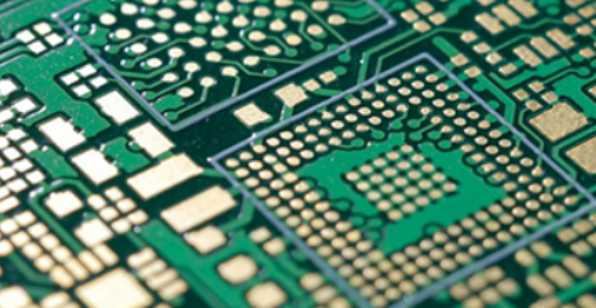
To install the capacitor, pull a short lead wire from the pad and connect it to the power plane through the hole, as well as the ground end. In this way, the current loop through the capacitor is: power plane - "through the hole -" lead wire - "pad -" capacitor - "pad -" lead wire - "through the hole -" ground plane, FIG. 2 intuitively shows the return path of the current.
The first method leads a long lead wire from the pad and connects it through the hole. This introduces a large parasitic inductance. It must be avoided.
The second method is to drill holes in the two ends of the pad next to the pad, which is much smaller than the first method, and the parasitic inductance is also smaller, which is acceptable.
The third in the side of the pad drilling, further reduce the loop area, parasitic inductance is smaller than the second, is a better method.
The fourth is drilled on both sides of the pad. Compared with the third method, each end of the capacitor is connected to the power plane and ground plane in parallel through the hole, which is smaller than the third parasitic inductance. As long as the space allows, try to use this method.
The last method is to punch holes directly on the pad, the parasitic inductance is minimal, but welding is likely to cause problems, whether to use depends on the processing capacity and way.
The third and fourth methods are recommended.
It is important to note that some engineers, in order to save space, sometimes have multiple capacitors use common through-holes. Do not do this under any circumstances. It is best to find ways to optimize the design of the capacitor combination and reduce the number of capacitors.
Because the wider the printed line, the smaller the inductance, from the pad to the hole lead as wide as possible, and if possible, try to be the same width as the pad. This allows you to use 20mil wide leads even for 0402 capacitors. Leadout and through-hole installation is shown in Figure 4. Note the various sizes in the figure.
In PCB design, how to control the relationship between line width and current?
We generally have a common sense when drawing PCB, that is, use thick lines (such as 50mil, or even above) where the current is high, and use thin lines (such as 10mil) for signals with low current.
For some electromechanical control systems, sometimes the instantaneous current flowing through the wire can reach more than 100A, so the relatively thin wire will certainly cause problems.
A basic rule of thumb is 10A/ mm2, that is, 10A for a cable with a cross-sectional area of 1 mm2. If the wire width is too thin, it will burn out when a large current passes through it. Of course, the current burning wire should also follow the energy formula: Q=I*I*t. For example, for a 10A current wire, a 100A current burr suddenly appears, with a duration of us level, then the 30mil wire is sure to be able to withstand. (At this time, there will be another problem, the stray inductance of the wire, the burr will produce a strong reverse electromotive force under the action of this inductance, which may damage other components. The thinner and longer the wire, the larger the stray inductance, so in practice, the length of the wire should be considered.) General PCB rendering software often has several options when laying copper on the through hole welding plate of the device pin: right Angle spoke, 45 degree Angle spoke, straight laying. What's the difference? Novices often do not care too much, just choose one, beautiful on the line.

Not so much. There are two main considerations:
One is to consider not too fast heat dissipation, the second is to consider the current capacity. The use of direct paving mode is characterized by a strong overcurrent capacity of the pad, for high-power circuit device pins must be used in this way. At the same time, its thermal conductivity is also very strong, although the work is good for the heat dissipation of the device, but this is a problem for the circuit board welding personnel, because the heat dissipation of the welding plate is too fast and not easy to hang tin, often need to use larger wattage iron and higher welding temperature, reduce the production efficiency. The use of right Angle spokes and 45 Angle spokes will reduce the contact area between the pin and the copper foil, slow heat dissipation, and welding will be much easier.
Therefore, the connection mode of copper paving through the hole welding plate should be selected according to the application situation, the comprehensive overcurrent capacity and heat dissipation capacity should be considered together. The signal line of low power should not be directly paved, and the welding plate must be directly paved through the high current. Whether it's a right Angle or a 45 degree Angle is beautiful.
Why bring this up? Because I was researching a motor driver a while ago, the device of the H bridge in this driver kept burning out, and I couldn't find the reason for it for four or five years. After a lot of hard work, I finally found that it was the welding disc of a device in the power loop that used the mode of right-angle spokes when laying copper (and due to the poor copper laying, only two spokes actually appeared). This makes the overcurrent capacity of the whole power loop greatly reduced.
Although the product does not have any problems in the normal use process, it works perfectly normally under the condition of 10A current. However, when there is a short circuit in the H bridge, there will be a current of about 100A in the circuit, and the two spokes will be burned out instantaneously (Class uS). Then, the power loop becomes a circuit breaker, and the energy stored in the motor is dissipated through all possible ways without a drain channel. This energy will burn the current measuring resistance and related op-amp devices, destroy the bridge control chip, and enter the signal and power supply of the digital circuit part, causing serious damage to the entire equipment. The whole process was as thrilling as detonating a large landmine with a single strand of hair.
Then you may ask, why only two spokes are used in the pad in the power loop? Why don't you just lay the foil across? Because, hehe, the production people said that this pin is too difficult to solder! The designers listened to the production people, and that's why... Alas, it really took me a lot of thought to find this problem, which is so simple to say, I know the pain and joy! If the hole of via is smaller than 0.3mm, there is no way to use mechanical drilling. If laser drilling is used, the production and processing of the plate will be more difficult. So my personal idea is that the minimum is 0.5mm outside /0.3mm inside if not very much needed. But things like computer motherboards, memory strips, dense BGA packages, etc., can sometimes be as small as 14mil/8mil.
My personal opinion is that the diameter of the hole should be 1.5 times the width of the wire, although this is not necessary for special thickened wires (e.g. power supply, etc.).






